
The Nitro Group in Organic Synthesis
.pdf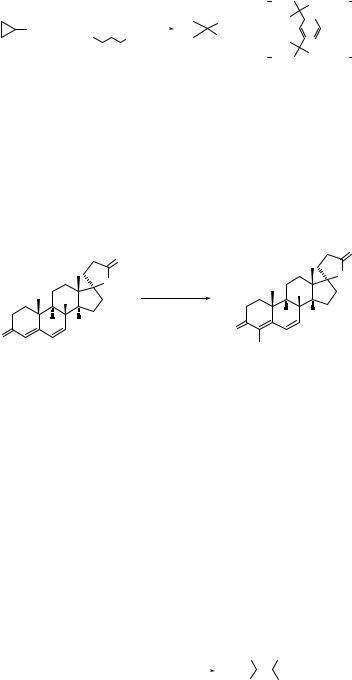
2.1 NITRATION OF HYDROCARBONS 11
1-Nitrocyclopropane-1-carboxylate is prepared in 71% yield by nitration of the enolate derived from the cyclopropane carboxylate with isoamyl nitrate (Eq. 2.24). It is a precursor of α-amino acid, containing a cyclopropane ring.44
CO2R |
1) t-BuLi, –78 ºC |
|
CO2R |
R= |
|
|
|
|
|
OMe |
(2.24) |
||
|
|
|
|
|
|
||||||||
|
|
|
|
|
|
||||||||
|
|
|
|
NO2 |
|
|
|
|
|
||||
2) |
|
ONO2 |
|
|
|
|
|
|
|
|
|
||
|
|
|
|
|
|
|
|
||||||
|
|
|
|
71% |
|
|
|
|
|
|
|
|
|
|
|
|
|
|
|
|
|
|
|
|
|||
2.1.4 Alkenes
Nitration of alkenes gives conjugated nitroalkenes, which are useful and versatile intermediates in organic synthesis. Nitroalkenes are generally prepared either by nitration of alkenes or dehydration of 2-nitro alcohols formed via the Henry reaction (see Section 3.2.1). Nitration of alkenes with HNO3 gives nitroalkenes in moderate yields, but this process has not been used for organic synthesis in a laboratory because of the lack of selectivity and decomposition of alkenes. Early references are found in Ref. 1. Nitration of the steroid canrenone using nitric acid and acetic anhydride occurs at the 4-position in 52% yield (Eq. 2.25).45 This regiochemistry is noteworthy; early papers on nitration of the steroids with HNO3 report the nitration at the 6-position.46
|
|
O |
|
O |
|
|
|
|
|
|
O |
|
|
O |
|
HNO3, Ac2O |
|
H |
|
H |
|
|
||
|
CH2Cl2 |
|
(2.25) |
|
|
|
H |
||
H H |
|
1 h, 25 ºC |
H |
|
|
O |
|
||
|
|
|
||
O |
|
|
|
|
|
|
NO2 |
|
|
|
|
|
|
A convenient preparative method for conjugated nitroalkenes has been developed based on the reaction of nitrogen oxides. Nitric oxide (NO) is commercially available and used in the industry for the mass production of nitric acid. Nitric oxide is currently one of the most studied molecules in the fields of biochemistry, medicine, and environmental science.47 Thus, the reaction of NO with alkenes under aerobic conditions is of a renewed importance.48
There are many reports for nitration of alkenes using various nitrating agents, which proceeds via an ionic or radical addition process.49 Nitration of cyclohexene with acetyl nitrate gives a mixture of β-and γ-nitrocyclohexenes, 1,2-nitroacetate, and 1,2-nitronitrate. This reaction is not a simple ionic or radical process; instead, [2+2] cycloaddition of nitryl cation is proposed.50
Two important methods for the preparation of nitroalkenes are reported in Collective Volume 6 in Organic Synthesis. Methyl 3-nitroacrylate, which is a very important reagent for organic synthesis, is prepared by the reaction of methyl acrylate with N2O4 in the presence of iodine, which is followed by the subsequent treatment with sodium acetate (Eq. 2.26).51 The reaction of alkenes with nitrogen oxides in the presence of oxygen gives a mixture of vicinal nitro nitrates and dinitro compounds, which are precursors of nitroalkenes. Thus, 1-nitrocyclooctene is prepared in 63–64% yield by the reaction of cyclooctene and N2O4 in the presence of O2 (Table 2.2).52
|
1) N2O4, I2 |
O2N |
|
H |
CH2=CHCO2Me |
|
|
|
|
|
|
|
(2.26) |
|
2) AcONa |
|
|
||
|
H |
|
CO2Me |
|
|
|
|
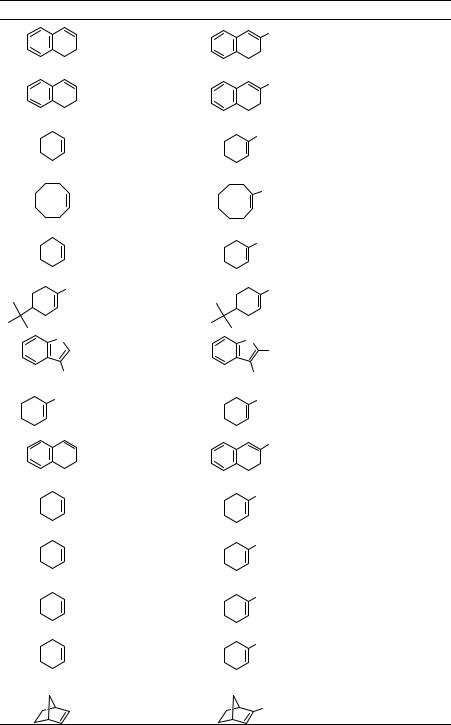
12 PREPARATION OF NITRO COMPOUNDS
Table 2.2 Preparation of cyclic nitroalkenes via nitration
Cyclic alkenes |
Reagent |
Product |
Yield (%) |
Ref. |
|
NO |
NO2 |
86 |
53 |
|
Al2O3 |
|
|
|
|
NO |
NO2 |
76 |
54 |
|
|
|||
|
H-zeolite |
|
|
|
|
NO |
NO2 |
|
|
|
|
|
|
|
|
H-zeolite |
|
86 |
54 |
|
1) N2O4, O2 |
NO2 |
|
|
|
|
|
|
|
|
2) Et3N |
|
63 |
52 |
|
1) PhSeBr, AgNO2 |
NO2 |
|
|
|
HgCl2 |
81 |
66 |
|
|
|
|||
|
2) H2O2 |
|
|
|
SnMe3 |
C(NO2)4, DMSO |
NO2 |
94 |
37 |
|
|
|||
O |
1) t-BuLi/THF |
O |
|
|
|
Me3SnCl |
NO |
72 |
72 |
|
2) C(NO2)4, |
2 |
|
|
|
|
|
|
|
CH3 |
DMSO |
CH3 |
|
|
|
|
|
||
SiMe3 |
|
NO2 |
|
|
|
AcONO2 |
|
73 |
73 |
|
1) KNO2, |
NO2 |
|
|
|
18-crown-6, I2, |
90 |
64 |
|
|
|
|||
|
THF |
|
|
|
|
2) pyridine |
|
|
|
|
NaNO2 |
NO2 |
|
|
|
|
|
|
|
|
Ce(NH4)3(NO3)6 |
|
|
|
|
AcOH |
|
96 |
56 |
|
NaNO2, NaNO3 |
NO2 |
41 |
59 |
|
|
|||
|
anodic oxidation |
|
|
|
|
NaNO2, I2 |
NO2 |
72 |
63 |
|
|
|||
|
HOCH2CH2OH |
|
|
|
|
1) NaNO2, HgCl2 |
NO2 |
92 |
74 |
|
|
|||
|
2) NaOH |
|
|
|
|
1) NaNO2, HgCl2 |
NO |
90 |
74 |
|
2) NaOH |
2 |
|
|
|
|
|
|
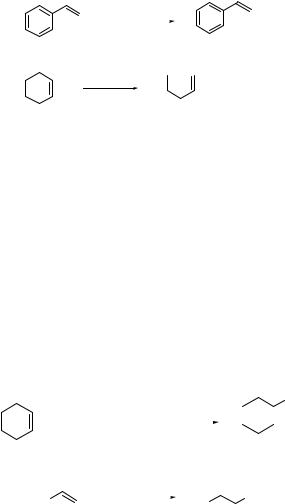
2.1 NITRATION OF HYDROCARBONS 13
A very attractive method for the preparation of nitroalkenes, which is based on the reaction with NO, has been reported. Treatment of alkenes at ambient pressure of nitrogen monoxide (NO) at room temperature gives the corresponding nitroalkenes in fairly good yields along with β-nitroalcohols in a ratio of about 8 to 2. The nitroalcohol by-products are converted into the desired nitroalkenes by dehydration with acidic alumina in high total yield. This simple and convenient nitration procedure is applied successfully to the preparation of nitroalkenes derived from various terminal alkenes or styrenes (Eq. 2.27).53 This process is modified by the use of HY-zeolites instead of alumina. The lack of corrosiveness and the ability to regenerate and reuse the catalyst make this an attractive system (Eq. 2.28).54
 NO2
NO2
NO
acidic Al2O3 |
(2.27) |
|
95% |
 NO2
NO2
NO
H-zeolite
(2.28)
86%
Addition of the NO2 radical to alkenes, followed by oxidation to a carbocation or by halogenation is now widely used for the preparation of nitroalkenes. However, the use of dinitrogen tetroxide is not simple in the laboratory because N2O4 is very toxic and a small syringe for this gas is rather expensive. To avoid the use of N2O4, several nitrating systems using liquid or solid reagents have been developed.
The direct conversion of styrene to β-nitrostyrene using clay doped with nitrate salts has been reported. Styrene and clayfen (iron nitrate on clay) or clayan (ammonium nitrate on clay) are mixed well and then heated at 100–110 °C in solid state to give β-nitrostyrene in 68% yield.55a A more simple one-pot synthesis of β-nitrostyrene from styrene has been reported; β-nitrostyrene is prepared in 47% yield on treatment of styrene with CuO HBF4, I2, and NaNO2 in MeCN at room temperature.55b
Sonication of a chloroform solution containing the alkenes, NaNO2 (10 equiv), Ce(NH4)2(NO3)6 (2.0 equiv), and acetic acid (12 equiv) in a sealed tube at 25–73 °C provides an excellent way to prepare nitroalkenes. For example, cyclohexene is converted into 1-nitrocyclohexene in 96% yield by this method (Eq. 2.29).56 When the reaction is carried out in acetonitrile, the carbocation intermediates are trapped by acetonitrile to give nitroacetamides in good yield.57 Analogous nitroacetamidation is possible by using nitronium tetrafluoroborate and acetonitrile (Eq. 2.30).58
|
|
|
|
|
|
|
|
|
NO2 |
|
NaNO2, Ce(NH4)2(NO3)6 |
|
|
|
(2.29) |
||||
|
|
AcOH |
|
|
|
|
|
|
|
|
|
|
|
|
|
|
|
|
|
|
|
|
96% |
|
|||||
|
|
NO2BF4 |
|
NHAc |
|
||||
Ph |
|
|
|
|
NO2 |
(2.30) |
|||
|
|
|
|
|
|||||
|
MeCN |
|
|
|
|||||
|
|
Ph |
|
||||||
|
|
|
84% |
|
|
|
|
||
Electrochemical oxidation of a mixture of alkenes, NaNO2 and NaNO3, in water is also a good method for the preparation of nitroalkenes.59
The regioselective addition of nitryl iodide to alkenes, followed by base-induced elimination, gives nitroalkenes. Nitryl iodide is generally prepared by the reaction of AgNO2 and iodine.
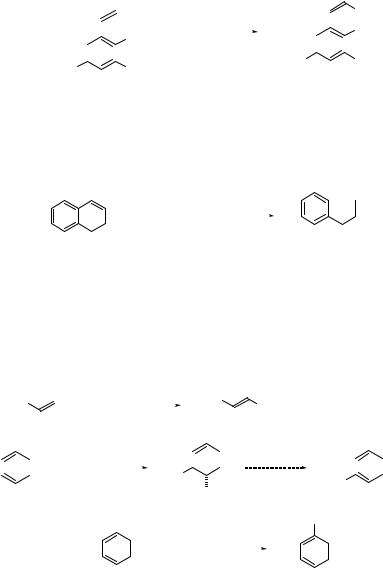
14 PREPARATION OF NITRO COMPOUNDS
The synthetic applications of this reagent to the synthesis of nitroalkenes have been known since the 1960s.60 Nitration of alkenes with nitryl iodide, generated in situ from iodine and silver nitrite, is convenient for the synthesis of β-nitrostyrenes with various functional groups.61 This method is applied to the synthesis of ortho-methoxylated phenylisopropylamines, which are potent serotonine agonists (Eq. 2.31).62
|
|
|
|
CH3 |
|
|
|
|
|
CH3 |
|
|
|
|
|
|
|
|
|
|
|
|
|
|
|
|
|
|
1) AgNO2, I2 |
|
|
|
|
NO2 |
|
|
|
|
|
|
|
|
|
|
|||
|
|
|
|
OMe |
|
|
|
OMe |
(2.31) |
||
|
|
|
|
|
|
|
|||||
|
|
|
|
2) Et3N |
|
|
|
|
|||
|
|
|
|
|
|
|
|
|
|||
|
|
|
|
|
|
|
|
|
|
||
|
|
|
|
|
|
|
|
|
|
||
MeO |
|
|
|
OMe |
|
MeO |
80% |
OMe |
|
||
|
|
|
|
||||||||
|
|
|
|
|
|
|
|||||
|
|
|
|
|
|
|
|
|
|||
Replacement of silver nitrite by inexpensive sodium or potassium nitrite enhances the utility of this process. Treatment of alkenes with sodium nitrite and iodine in ethyl acetate and water in the presence of ethylene glycol gives conjugated nitroalkenes in 49–82% yield.63 The method for generation of nitryl iodide is improved by the treatment of iodine with potassium nitrite complexed with 18-crown-6 in THF under sonication, as shown in Eq. 2.32.64
1) KNO2, I2, 18-crown-6,  NO2
NO2
THF, RT, )))) |
(2.32) |
|
2) pyridine |
||
|
||
|
90% |
Nitrosulfonylation using sodium nitrite and sulfenyl halides65 or nitroselenation using phenylselenyl bromide, silver nitrite, and mercuric chloride,66 as shown in Eq. 2.33 may be useful for the preparation of conjugated nitroalkenes from alkenes. 2-Nitro-1,3-dienes are prepared from the corresponding conjugated 1,3-dienes via a nitroselenation-elimination sequence (Eq. 2.34).67 Such nitrodienes are of interest synthetically for further reaction with electron-rich alkenes like enol ethers or enamines.68 They are also transformed into synthetically useful 3,4-epoxy-3-nitro- 1-alkenes.69 On the other hand, the reaction of conjugated dienes with ammonium nitrate in trifluoroacetic anhydride gives 1-nitro-1,3-dienes in good yield (Eq. 2.35).70
Me3Si |
|
|
1) PhSeBr |
|
|
|
Me3Si |
|
|
|
|
|||
|
|
2) AgNO2/ HgCl2 |
|
|
NO2 |
(2.33) |
||||||||
|
|
|
|
66% |
|
|
|
|
|
|||||
|
|
|
|
3) H2O2 |
|
|
|
|
|
|
|
|||
|
|
|
|
|
|
|
|
|
|
|
|
|
|
|
|
|
|
1) PhSeBr |
|
|
|
|
|
|
|
|
|
(2.34) |
|
|
|
|
|
|
|
|
|
|
|
|
|
|||
|
|
|
|
|
|
|
|
|
|
|
|
|||
|
|
|
2) AgNO2/ HgCl2 |
O2N |
|
|
|
|||||||
|
|
|
|
O2N |
||||||||||
|
|
|
|
|
|
|
|
SePh |
|
|||||
|
|
|
|
|
|
|
|
|
|
|
|
|||
|
|
|
|
|
|
|
NH4NO3, TFA |
NO2 |
||||||
|
|
|
|
|
|
|
(2.35) |
|||||||
|
|
|
|
|
|
|
|
|
|
|
||||
HBF4, CH2Cl2
20 ºC, 15 h
70%
Cyclic nitroalkenes are prepared from cyclic ketones via nitration of vinylstannanes with tetranitromethane in DMSO, as shown in Eq. 2.36, where DMSO is a critical choice of solvent for replacing tin by nitro at the unsaturated carbon. The conversion of ketones to vinylstannanes
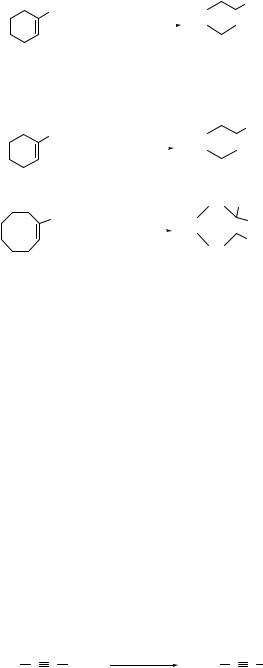
2.1 NITRATION OF HYDROCARBONS 15
can be performed in good yield via arylhydrazone intermediates.71 Regioselective nitration of 3-alkyl-1-benzofurans at the 2-position is also possible by stannylation and treatment with tetranitromethane in DMSO.72
SnMe3 |
|
|
|
|
NO2 |
C(NO2)4 |
|
|
|
(2.36) |
|
|
|
|
|
||
|
DMSO |
|
|
|
|
|
|
|
|
|
|
|
|
80% |
|||
The reaction of acetyl nitrate with cyclic vinylsilanes gives 1-nitrocycloalkenes or 1,1-dinitro 2-nitrated cycloalkanes, depending on the ring size, as shown in Eqs. 2.37 and 2.38.73
SiMe3 |
AcONO2 |
|
|
|
|
|
|
NO2 |
|
|
|
|
|
|
|
|
(2.37) |
||
|
|
|
|
|
|
|
|
||
|
–15 ºC |
|
|
|
|
|
|
|
|
|
|
|
|
|
|
|
|
|
|
|
|
73% |
|
||||||
SiMe3 |
|
|
|
|
|
|
|
NO2 |
|
|
|
|
|
|
|
|
|
||
AcONO2 |
|
|
|
|
|
|
NO2 |
(2.38) |
|
|
|
|
|
|
|
||||
|
|
|
|
|
|
|
|||
|
–15 ºC |
|
|
|
|
|
|
ONO2 |
|
|
|
|
|
|
|
|
|
||
|
|
|
|
|
|
||||
|
|
70% |
|
||||||
In 1978, Corey reported a general synthetic route for the conversion of alkenes to conjugated nitroalkenes via nitro-mercuration and demercuration.74 Since then, many chemists have used this method for the preparation of cyclic nitroalkenes such as 1-nitrocyclohexene. However, the use of mercury salts is not recommended even for the small-scale preparation of nitroalkenes. This reaction is not as clean as expected, and formidable efforts are required to remove the mercury in the waste.
The synthesis of cyclic nitroalkenes via nitration of cycloalkenes is summarized in Table 2.2. Acyclic nitroalkenes are more readily prepared via the Henry reaction than by nitration of alkenes (see Section 3.2.1).
Because nitration of alkenes with nitronium salts proceeds via carbocation intermediates, nitration of electron-deficient alkenes with nitronium salts is rare. Only a few cases are reported. The reaction of α,β-unsaturated esters with nitronium salts affords products via highly reactive α-carbonyl cations.75
Nitration of aromatics or alkenes with nitronium tetrafluoroborate gives a variety of nitro compounds.1 However, this process is not always useful because the reagent is expensive and very moisture sensitive. The difficulty is solved by the use of an electrochemically-generated nitronium salt. Anodic oxidation of an acetonitrile solution of nitrogen dioxide at constant current (500 mA/cm2) using a divided H-cell (Pt electrode, LiBF4 as electrolyte) gives a solution of NO2BF4, which effectively nitrates aromatics, enol silyl ethers, alkenes, and dienes to give, respectively, nitroaromatics, α-nitro ketones, vicinal nitroamides, and nitroacetamides.76
Nitration of acetylenes with nitryl iodide followed by elimination of HI gives nitroacetylenes, but nitroacetylenes are too thermally unstable to be useful for organic synthesis.77 Recently, nitro-trimethylsilyl-acetylenes are prepared as stable nitroacetylenes by the reaction of bis(trimethylsily)acetylene with nitronium tetrafluoroborate (Eq. 2.39).78
Me3Si C C SiMe3 |
NO2BF4 |
Me3Si C C NO2 |
(2.39) |
|
70%

16 PREPARATION OF NITRO COMPOUNDS
2.1.5 Synthesis of =-Nitro Ketones
Nitration of ketones or enol ethers provides a useful method for the preparation of α-nitro ketones. Direct nitration of ketones with HNO3 suffers from the formation of a variety of oxidative by-products. Alternatively, the conversion of ketones into their enolates, enol acetates, or enol ethers, followed by nitration with conventional nitrating agents such as acyl nitrates, gives α-nitro ketones (see Ref. 79, a 1980 review). The nitration of enol acetates of alkylated cyclohexanones with concentrated nitric acid in acetic anhydride at 15–22 °C leads to mixtures of cisand trans-substituted 2-nitrocyclohexanones in 75–92% yield. 4-Monoalkylated acetoxycyclohexanes give mainly cis-compounds, and 3-monoalkylated ones yield trans-compounds (Eq. 2.40).80
OAc |
|
|
O |
||||||
|
|
|
|
|
NO2 |
||||
|
|
|
|
|
|
|
|
||
|
|
|
HNO3-Ac2O |
|
|
|
|
(2.40) |
|
|
|
|
|||||||
|
|
|
15–22 ºC |
|
|
||||
|
|
|
|
|
|||||
|
|
|
|
|
|
|
|
||
|
|
|
|
|
R |
||||
R |
|||||||||
|
|
75–92% |
|||||||
|
|
|
|
|
|||||
Nitration of the potassium enolates of cycloalkanones with pentyl nitrate81 or nitration of silyl enol ethers with nitronium tetrafluoroborate82 provides a method for the preparation of cyclic α-nitro ketones. Trifluoroacetyl nitrate generated from trifluoroacetic anhydride and ammonium nitrate is a mild and effective nitrating reagent for enol acetates (Eq. 2.41).83
|
|
|
|
|
|
|
|
O |
||||
OAc |
|
O2N |
|
|
|
|
||||||
|
|
|
(CF3CO)2O |
|
|
|
|
|
|
|
|
(2.41) |
|
|
|
|
|
||||||||
|
|
|
NH4NO3 |
|
|
|
|
|
|
|
|
|
|
|
|
H |
|||||||||
|
|
|
|
|
|
|||||||
|
|
|
|
|
100% |
|
|
|
||||
Cyclic and acyclic silyl enol ethers can be nitrated with tetranitromethane to give α-nitro ketones in 64–96% yield (Eqs. 2.42 and 2.43).84 The mechanism involves the electron transfer from the silyl enol ether to tetranitromethane. A fast homolytic coupling of the resultant cation radical of silyl enol ether with NO2 leads to α-nitro ketones. Tetranitromethane is a neutral reagent; it is commercially available or readily prepared.85
OSiMe3 |
|
O |
|
R |
C(NO2)4 |
R |
|
NO2 |
|
||
|
DMSO |
(2.42) |
|
X |
X |
|
|
|
|
||
X = H, OMe; R = H, Me |
|
92–95% |
|
OSiMe3 |
|
O |
|
C(NO2)4 |
|
|
|
|
|
(2.43) |
|
|
DMSO |
NO2 |
|
|
|
||
|
|
90% |
|
A novel one-pot synthesis of α-nitro ketones from alkenes has been observed on treatment with trimethylsilyl nitrate-chromium trioxide or a trimethylsilyl nitrate-DMSO reagent system (Eq. 2.44).86

|
|
|
2.1 NITRATION OF HYDROCARBONS 17 |
|||
|
|
|
|
|
|
|
Me3SiONO2 |
|
|
O |
Reagent |
Yield (%) |
|
|
|
|
|
|
||
|
|
(2.44) |
CrO3 |
61 |
|
|
|
|
|
|
|||
|
|
|
NO2 |
|||
|
|
|
DMSO |
73 |
|
|
|
|
|
|
|
||
|
|
|
|
|
|
|
α-Nitro ketones, which are important intermediates for organic synthesis, are alternatively prepared either by oxidation of 2-nitroalcohols (see Section 3.2.3) or by acylation of nitroalkanes (see Section 5.2). Synthetic application of cyclic α-nitro ketones has been well summarized in recent reviews.87,88 Because α-nitrocycloalkanones are more readily prepared than nitrocycloalkenes, the former can be used as precursors for nitrocycloalkenes (Eq. 2.45).89 Sodium borohydride reduction of α-nitro ketones and successive dehydration with Ac2O N,N-dimethyl- aminopyridine (DMAP) and basic alumina gives, in a one-pot procedure, conjugated nitrocycloalkenes.
|
O |
|
OH |
|
Me |
NO2 |
|
Me |
NO2 |
|
|||
Me |
NaBH |
Ac O |
||||
NO2 |
4 |
|
2 |
|
|
|
|
|
|
|
DMAP |
|
|
|
|
|
|
Al2O3 |
|
(2.45) |
|
|
|
65% |
|
|
60% |
Ring cleavage of cyclic 2-nitro ketones by external nucleophiles gives a variety of functionalized nitro compounds, ketones, or carboxylic acids. The ring cleavage of 2-nitrocycloal- kanones with ROH-KF gives ω-nitro esters (Eq. 2.46).90 A significant improvement of this ring cleavage is obtained by using Amberlyst A-21.91
O
NO2 |
ROH |
O2N |
CO2R |
(2.46) |
|
KF |
|||
|
|
70–98% |
|
|
|
|
|
|
2.1.6 Nitration of Alkyl Halides
The reaction of alkyl halides with metal nitrites is one of the most important methods for the preparation of nitroalkanes. As a metal nitrite, silver nitrite (Victor-Meyer reaction), potassium nitrite, or sodium nitrite (Kornblum reaction) have been frequently used. The products are usually a mixture of nitroalkanes and alkyl nitrites, which are readily separated by distillation (Eq. 2.47). The synthesis of nitro compounds by this process is well documented in the reviews, and some typical cases are listed in Table 2.3.92a Primary and secondary alkyl iodides and bromides as well as sulfonate esters give the corresponding nitro compounds in 50–70% yields on treatment with NaNO2 in DMF or DMSO. Some of them are described precisely in vol 4 of Organic Synthesis. For example, 1,4-dinitrobutane is prepared in 41–46% yield by the reaction of 1,4-diiodobutane with silver nitrite in diethyl ether.92b 1-Nitrooctane is prepared by the reaction with silver nitrite in 75–80% yield. The reaction of silver nitrite with secondary halides gives yields of nitroalkanes of about 15%, whereas with tertiary halides the yields are 0–5%.92c Ethyl α-nitrobutyrate is prepared by the reaction of ethyl α-bromobutyrate in 68–75% yield with sodium nitrite in DMF.92d Sodium nitrite is considerably more soluble in DMSO than in DMF; as a consequence, with DMSO, much more concentrated solutions can be employed and this makes shorter reaction times possible.92e
RX + NO2– |
|
RNO2 + RONO |
(2.47) |
|
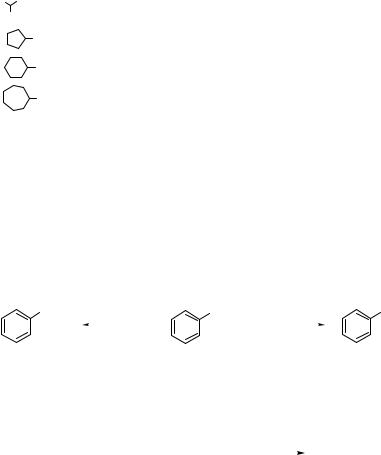
18 PREPARATION OF NITRO COMPOUNDS
Table 2.3 Synthesis of nitroalkanes from alkyl halides
RX |
NO− |
Solvent |
RNO (%) |
RONO (%) |
|
2 |
|
2 |
|
n-C4H9Br |
AgNO2 |
Et2O |
73 |
|
n-C8H17Br |
AgNO2 |
Et2O |
80 |
|
i-C3H7Br |
AgNO2 |
Et2O |
20 |
31 |
n-C6H13Br |
NaNO2 |
DMF |
61 |
29 |
n-C8H17Br |
NaNO2 |
DMF |
60 |
|
H3C (CH2)5CH3 |
NaNO2 |
DMF |
58 |
|
Br |
|
|
|
|
Br |
NaNO2 |
DMF |
57 |
25 |
Br |
NaNO2 |
DMF |
0 |
(product: |
|
|
|
|
cyclohexane) |
Br |
NaNO2 |
DMF |
55 |
|
|
|
|
|
|
Thus, the reaction of alkyl halides and α-halo esters with sodium nitrite provides a very useful synthetic method for nitroalkanes and α-nitro esters. However, ethyl bromoacetate is exceptional in that it fails to give ethyl nitroacetate on treatment with sodium nitrite.93 This is due to the acidic hydrogen of the ethyl nitroacetate, which undergoes a further reaction with sodium nitrite to give the oxidized products (see Section 6.1, which discusses the Nef reaction). In a similar way, the reaction of benzyl bromide with sodium nitrite at 25 °C gives benzoic acid predominantly. To get phenylnitromethane, the reaction must be carried out at low temperature (–16 °C) (Eq. 2.48).93
CO2H |
NaNO2 |
CH2Br |
NaNO2 |
CH2NO2 |
|
RT |
|
DMF |
(2.48) |
|
|
|
–16 ºC |
|
Several improved methods for the nitration of alkyl halides have been reported. For example, the use of KNO2 in the presence of 18-crown-694 or nitrite ion bounded to macroporous quaternary ammonium amberlite resin (amberlite IRA 900) improves the yield of nitro compounds (Eq. 2.49).95
|
|
|
+ IRA-900-NO |
– |
benzene |
|
|
|
|
BrCH CH CO Et |
|
O |
NCH CH CO Et |
||||||
|
|||||||||
2 |
2 |
2 |
|
2 |
2 |
2 |
2 |
2 |
|
|
|
|
|
|
|
|
100% |
(2.49) |
|
Mosher and coworkers have prepared 2-(2-nitroethyl)-1,3-dioxolane from the corresponding 2-bromo compounds by various procedures (Eq. 2.50).96 They found that IRA-900-NO−2 is best for this conversion.
The preparation of nitroalkanes from alkyl halides has been used extensively for organic synthesis. Interestingly, nitroalkylpyridine alkaloids, which have anti-macrofouling activity, are isolated from the Okinawan marine sponge Callyspongia sp. The synthesis of such compounds has been done by the nitration of the corresponding bromide with silver nitrite (Eq. 2.51). The biogenesis of nitroalkyl compounds is an interesting process, since nitroalkyl compounds are extremely rare metabolites of marine organisms.97
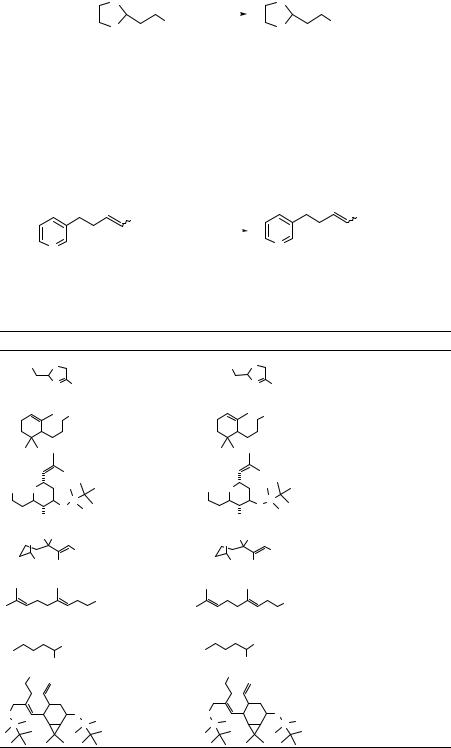
|
|
|
|
|
|
2.1 NITRATION OF HYDROCARBONS 19 |
||
|
O |
|
|
- |
|
O |
|
|
|
|
|
|
NO2 |
|
(2.50) |
||
|
|
|
|
|
|
|
||
|
O |
Br |
|
|
O |
NO2 |
||
|
|
|
|
|
|
|
|
|
|
|
Solvent |
|
|
Condition |
Yield (%) |
||
|
|
|
|
|
|
|
|
|
NaNO2 |
DMSO |
|
|
|
|
RT, 12 h |
35 |
|
NaNO2 |
DMSO-urea |
|
|
RT, 12 h |
36 |
|
||
KNO2 |
DMSO 18-crown-6 |
RT, 18 h |
37 |
|
||||
|
DMSO |
|
|
|
|
|
|
|
NaNO2 |
phloroglucinol |
|
|
RT, 18 h |
51 |
|
||
AgNO2 |
Et2O |
|
|
|
|
35 °C, 96 h |
47 |
|
IRA-900-NO− |
Benzene |
|
|
|
|
RT, 36 h |
82 |
|
2 |
|
|
|
|
|
|
|
|
|
(CH2)10Br |
AgNO2 |
|
(CH2)10NO2 |
||||
|
|
|
|
|||||
N |
|
|
|
Et2O, 48 h |
N |
(2.51) |
||
|
|
|
|
|
58% |
|
||
|
|
|
|
|
|
|
||
Table 2.4 Synthesis of nitro compounds from halides
Halide |
|
Condition |
Product |
Yield (%) |
Ref. |
|
Br |
O |
|
O2N |
O |
63 |
98 |
NaI, acetone |
|
|
||||
|
|
|
|
|
|
|
|
N Ph |
NaNO2, DMSO |
|
N Ph |
|
|
|
OTs |
NaI, DMF |
|
NO2 |
67 |
99 |
|
|
|
|
|||
|
|
NaNO2, DMF |
|
|
|
|
Br O |
|
AgNO2, Et2O |
NO2 O |
|
78 |
100 |
|
Si |
|
|
Si |
|
|
|
O |
|
|
O |
|
|
Me |
|
|
Me |
|
|
|
NC |
CO2Et |
|
NC |
CO2Et |
|
|
Me |
|
NaNO2, DMF |
Me |
|
58 |
101 |
|
Me |
|
Me |
|||
Br |
Et |
|
NO2 |
Et |
|
|
|
|
I NaNO2, DMSO |
|
NO2 |
60 |
102 |
|
(CH2)6Br |
NaNO2, DMSO |
|
(CH2)6NO2 |
70 |
103 |
|
OH |
|
OH |
|
|
|
I |
|
|
NO2 |
|
|
|
O |
O |
AgNO2, Et2O |
O |
O |
67 |
104 |
Si |
Si |
|
Si |
Si |
|
|

20 PREPARATION OF NITRO COMPOUNDS
A number of nitro compounds used in natural product synthesis have been prepared by the nitration of alkyl halides. Some recent examples are summarized in Table 2.4.
β-Nitro carbonyl compounds are important for synthesis of natural products. The reaction of alkyl vinyl ketones with sodium nitrite and acetic acid in THF gives the corresponding β-nitro carbonyl compounds in 42–82%.105 This method is better for the preparation of β-nitro carbonyl compounds than the nitration of the corresponding halides.
Schneider and Busch have showed that tetraaza[8.1.8.1]paracyclophane catalyzes the nitration of alkyl bromides with sodium nitrite. In dioxane-water (1:1) at 30 °C, the reaction of 2-bromomethylnaphthalene with sodium nitrite is accelerated by a factor of 20 in the presence of the catalyst.106 Concomitantly, the product ratio of [R-ONO]: [RNO2] changes from 0.50:1 to 0.16:1. Thus, an accumulation of nitrite ions at the positively charged cyclophanes or IRA-900-nitrite form provides a new method for selective nitration of alkyl halides.
2.2 SYNTHESIS OF NITRO COMPOUNDS BY OXIDATION
2.2.1 Oxidation of Amines
The direct oxidation of primary amines into the corresponding nitro derivatives is very useful for fundamental and industrial applications because it provides nitro compounds, which may otherwise be difficult to synthesize by direct nitration methods. Efficient synthetic methods for the conversion of primary amines into the nitro compounds are described in this section. Saturated primary amines undergo oxidation reactions by ozone to give the corresponding nitroalkanes accompanied by several other compounds depending on the reaction conditions.107 This drawback is overcome by ozonation on silica gel. Amines are absorbed on the silica gel by mixing with dry silica gel (dried for 24 h at 450 °C). The silica gel (ca 30 g) containing the amine (0.1–0.2 wt/wt%) was cooled to –78 °C and a stream of 3% of ozone in oxygen passed through it. By this procedure, nitro compounds are obtained in 60–70% yield (Eq. 2.52).108
1-Nitroadamantane is prepared by oxidation of 1-aminoadamantane with peracetic acid and ozone in 95% yield.109
|
|
|
O3 |
|
|||
R |
|
NH2 |
|
R |
|
NO2 |
(2.52) |
|
|
|
|||||
|
|
|
silica gel |
|
|||
|
|
|
|
60–70% |
|
||
The use of heterogeneous catalysts in the liquid phase offers several advantages compared with homogeneous counterparts, in that it facilitates ease of recovery and recycling. A chro- mium-containing medium-pore molecular sieve (Si:Cr > 140:1), CrS-2, efficiently catalyzes the direct oxidation of various primary amines to the corresponding nitro compounds using 70% t-butylhydroperoxide (TBHP).110
Aliphatic and aromatic primary amines are rapidly and efficiently oxidized to nitro compounds by dimethyldioxirane.111 Dimethyldioxirane is prepared by reaction of OXONE (DuPont trademark) 2KHSO5-KHSO4-K2SO4 with buffered aqueous acetone.112
In a typical reaction, n-butylamine (0.052 g, 0.7 mmol) in 5 ml of acetone is treated with 95 ml of dimethyldioxirane in acetone solution (0.05 M). The solution is kept at room temperature for 30 min with the exclusion of light (Eq. 2.53). Aromatic amines are converted into nitro compounds by oxidation using OXONE itself.113
R NH2 |
O O |
R NO2 |
(2.53) |
|
acetone |
||||
|
80–90% |
|
||
|
|
|
